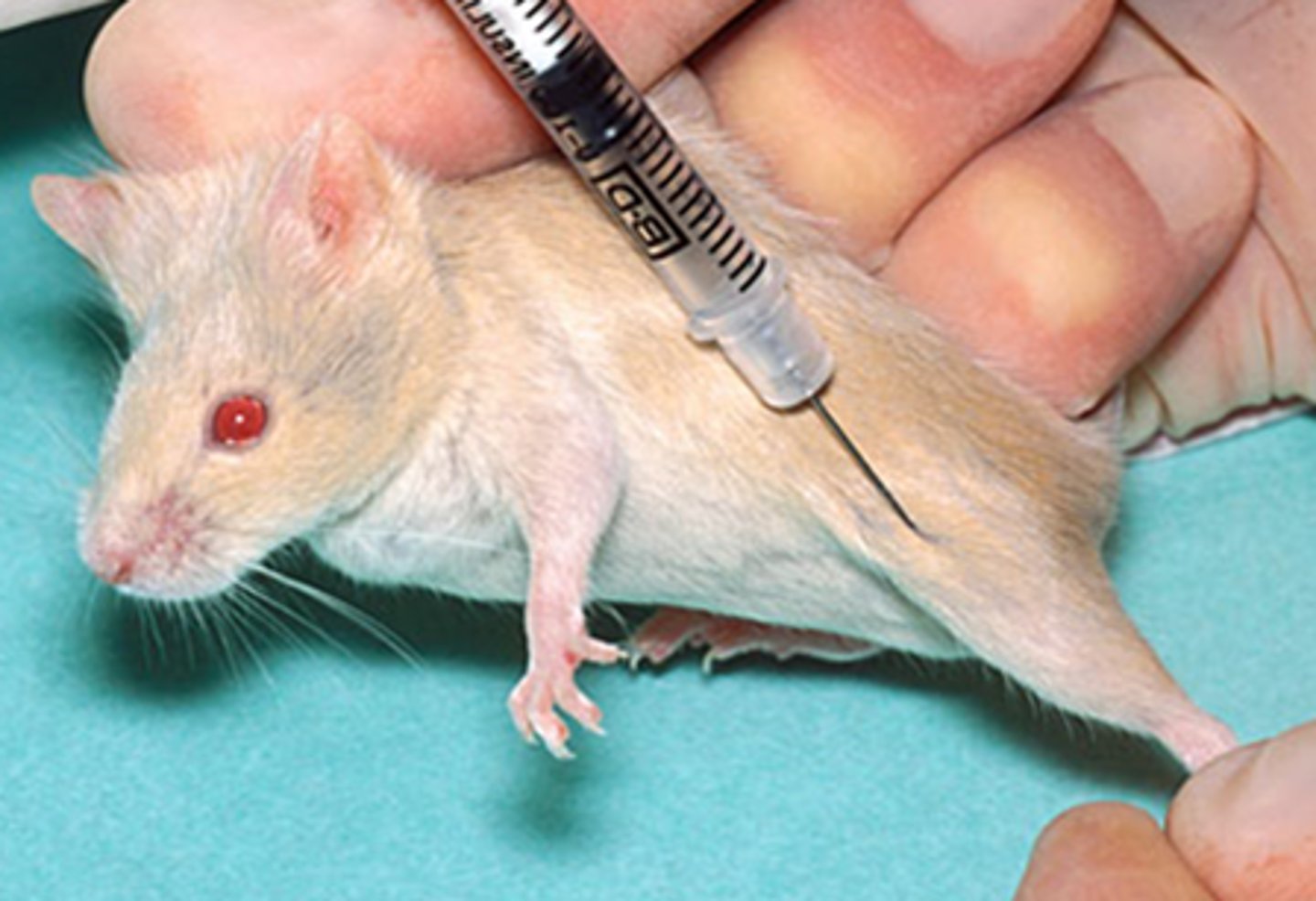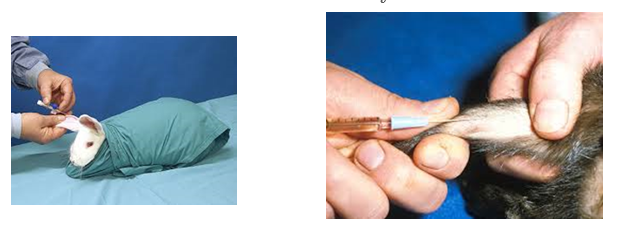Drug Administration and Antibiotics for Exotics
1/48
There's no tags or description
Looks like no tags are added yet.
Name | Mastery | Learn | Test | Matching | Spaced |
|---|
No study sessions yet.
49 Terms
What considerations must we have for small mammals when administering drugs?
High metabolic rate, small muscle mass (dosage), site of administration, take into account microflora of gut (don’t disrupt)
What considerations must we have for birds when administering drugs?
High metabolic rate, hide signs of illness, renal/hepatic portal system (don't put in caudal limbs & consider site of administration)
What considerations must we have for reptiles when administering drugs?
Exothermic (metabolism dependent on temperature), renal portal system and difficult to assess pain.
How are drugs adminstered enterally in exotics?
Mixed with food or fluid and fed by syringe or tube.
(be aware of bioavailability i.e. pharmacokinetics of drug)
Give at least 2 advantages of enteral administration in exotics
Economical
Can be administered by owner
Relatively safe
Give at least 2 disadvantages of enteral administration in exotics
Possibility of aspiration
Lack of palatability (won't consume voluntarily)
Slower onset of action (through digestive tract first, absorption rate slower)
First pass metabolism by liver can = reduced efficacy
Variable absorption
Describe enteral drug administration in birds
Practical if crop tubing —> inadvisable in drinking water/food —> unable to monitor dosage (sick birds unlikely to be eating/drinking properly), can make food or water taste strange/bitter, bioavailability considerations
Describe enteral drug administration in reptiles. What needs to be considered?
Challenging —> best by feeding tube
Be aware of GI shutdown between meals i.e. avoid in fasting reptiles
Consider POTZ —> temperature affects absorption, distribution, metabolism & excretion of drug
Hepatic portal system —> orally administered drugs often ineffective
Give at least 2 advantages of parenteral administration in exotics
Can use for drugs which are poorly absorbed orally (i.e. if GI system dysfunctional)
Can give immediate onset of action (IV)
Can give delayed onset of action (IM/SC)
Give at least 2 disadvantages of parenteral administration in exotics
Can be painful
Can be tricky in small patients (volumes etc.)
Peculiarities in reptiles/birds —> location of injection site must be carefully considered
Give at least 2 main parenteral administration strategies available for exotics
SC
IM
IV
IP
IO
What areas of a small mammal are appropriate for SC injection? Why?
Flanks, scruff (dorsal shoulder).
Need to allow for volume expansion
What are the considerations for SC injections in ferrets & guinea pigs?
Ferrets —> tough skin in scruff i.e. can be difficult to inject
Guinea pigs —> dorsal fat pad runs just behind ears so injecting in scruff can be painful
What gauge of needle should be used for rodents?
25-27g
What gauge of needle should be used for rabbits?
23-27g
What gauge needle should be used in ferrets?
25g (in most)
What gauge should be used in birds for SC?
Small birds = 27/27g
Others = 23/25g
How to SC inject in birds?
Use inguinal fold on inner thigh, half-way between body and stifle, or axillary region, or intrascapular (scruff!) region – for this stay close to elbows to avoid injection into the cervical air sac.
What is a consideration when SC injecting in reptiles?
Drug uptake can be slow/unreliable —> can be useful for administration of small volumes of fluid
How to SC inject in reptiles?
Snakes/Lizards – insert needle between scales on lateral aspect of body, no need to tent skin.
Chelonians – use ventral neck fold, or inguinal skin fold
Ensure needle inserted to reasonable depth (about half its length) to reduce seepage from injection site – SQ space less expansive.
What areas of a small mammal are appropriate for IM injection?
Paralumbar (rabbits, chinchillas and guinea pigs)
Quadriceps (ferrets rabbits and small rodents)

Where to IM inject in birds?
Pectorals, ideally close to keel bone i.e. muscle thickest here
Thighs (remember renal/hepatic portal systems)
What is the preferred route of administration in reptiles? Describe why
IM —> upper arm in chelonians & lizards, epaxial muscles in snakes
Avoid caudal half of body due to first pass effect of renal portal system/hepatic portal system
What areas of a small mammal are appropriate for IV injection?
Cephalic and lateral saphenous in ferrets and rabbits only.
Marginal ear vein in rabbits but risk of skin sloughing
(not practical for other small mammals)Tail veins in lab animals

What area do we IV inject in birds?
Right jugular vein —> bigger than left
Basilic vein
Medial metatarasal
What area do we IV inject in reptiles?
Right jugular in chelonians —> bigger than left
Tail vein in lizards & snakes
Which route is used in small animals vs reptiles (intraperitoneal vs intraceolomic)?
Intraperitoneal in small mammals
Intraceolomic in reptiles
What are the advantages of intraperitoneal administration in exotics?
Large absorptive surface (can put a lot of drug in there).
What are the disadvantages of intraperitoneal administration in exotics?
Variable and unpredictable uptake
Risks damage to organs and injection into organs
What is safe positioning for IP injection into rodents?
Low (caudal) right quadrant).
What is safe positioning for IP injection in rabbits?
Lower (caudal) left quadrant (with extreme caution due to large abdominal organs)
Why caution when intracoelomic injecting reptiles?
Lack of functional diaphragm
Where to intracoelomic inject reptiles?
Lizards = right caudal quadrant
Snakes = caudal third of coelom, cranial to cloaca
Chelonia = prefemoral fossa (just in front of rear limb)
How is intraosseus administration performed in small mammals?
Via catheter
Into greater trochanter of femur, proximal humerus or proximal tibia
How is intraosseus administration performed in birds?
Distal ulna or proximal tibia, avoid humerus/femur due to pneumatisation
How is intraosseous injections in reptiles administered?
Proximal tibia
(limited to lizards & chelonia)
What is required first before IO administration?
Heavy sedation or anaesthesia.
What consideration must we have when using antibiotics in small mammals?
Herbivorous species have important resident microbial populations important for gut health
Give at least 2 classes of antibiotics that we can use in small mammals
Medications for treating small mammals:
Metronidazole, Fluoroquinolones, Tetracyclines, Sulphonamides, Macrolides (except erythromycin!)
Aminoglycosides(??)
Give at least 2 antibiotics to avoid when treating small mammals
PLACE; Penicillins, Lincosamides, Aminoglycosides, Cephalosporins, Erythromycin
Give at least 2 antibiotics licensed for rabbits
Trimethoprim-sulphamethoxazole
Enrofloxacin
Fucidic acid
Gentamicin
Are there licensed antibiotics for ferrets?
No!
What antibiotics are commonly used for birds?
Fluoroquinolones
Penicillins/Cephalosporins
Aminoglycosides
Describe fluoroquinolone use in birds
-IM can cause necrosis
-Oral administration safe but tastes bitter
-Generally well tolerated
Describe penicillin/cephalosporin use in birds
High therapeutic index so safe
Need to give frequently due to high metabolic rate of birds
Describe aminoglycoside use in birds
Can be toxic so care with dehydrated patients
What antiotics are licensed for birds?
Enroflaxacin (baytril)
Give at least 2 antibiotics we can use for reptiles,
Cephalosporins
Fluoroquinalones
Sulphonamides
Metronidazole
Aminoglycosides
Some penicillins
What are the licensed antibiotics for reptiles?
Trimethoprim-sulphamethoxazole and enrofloxacin (Baytril).